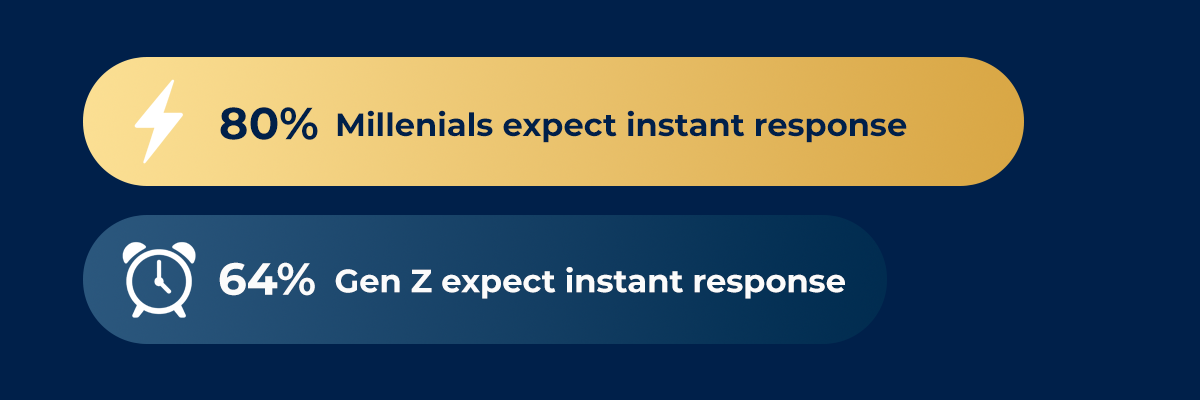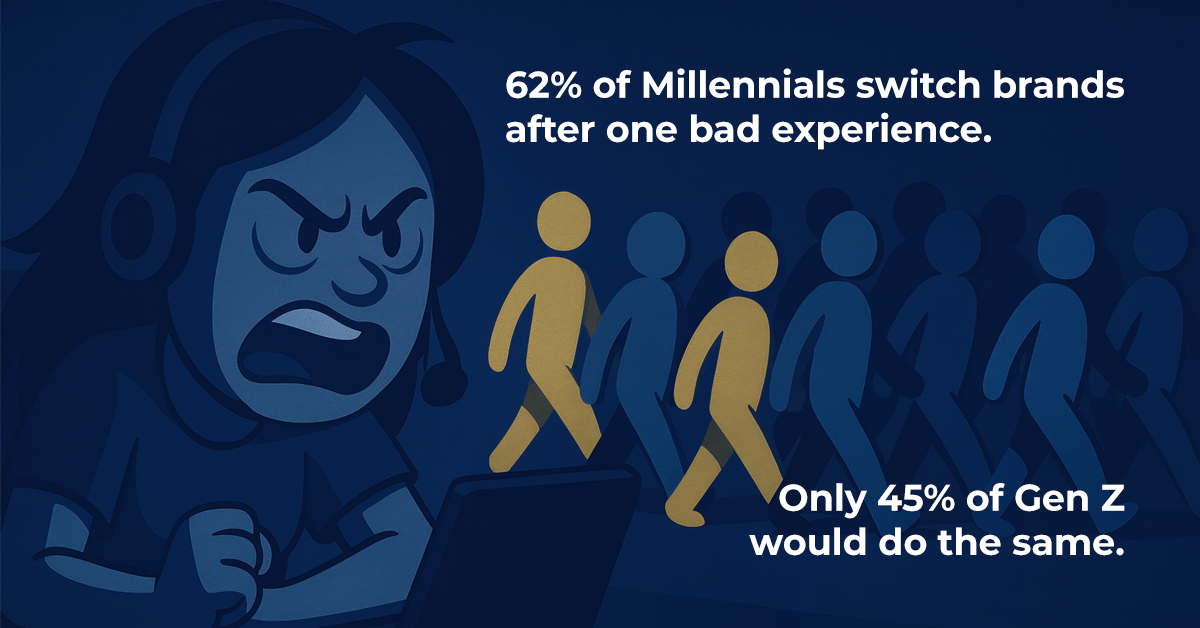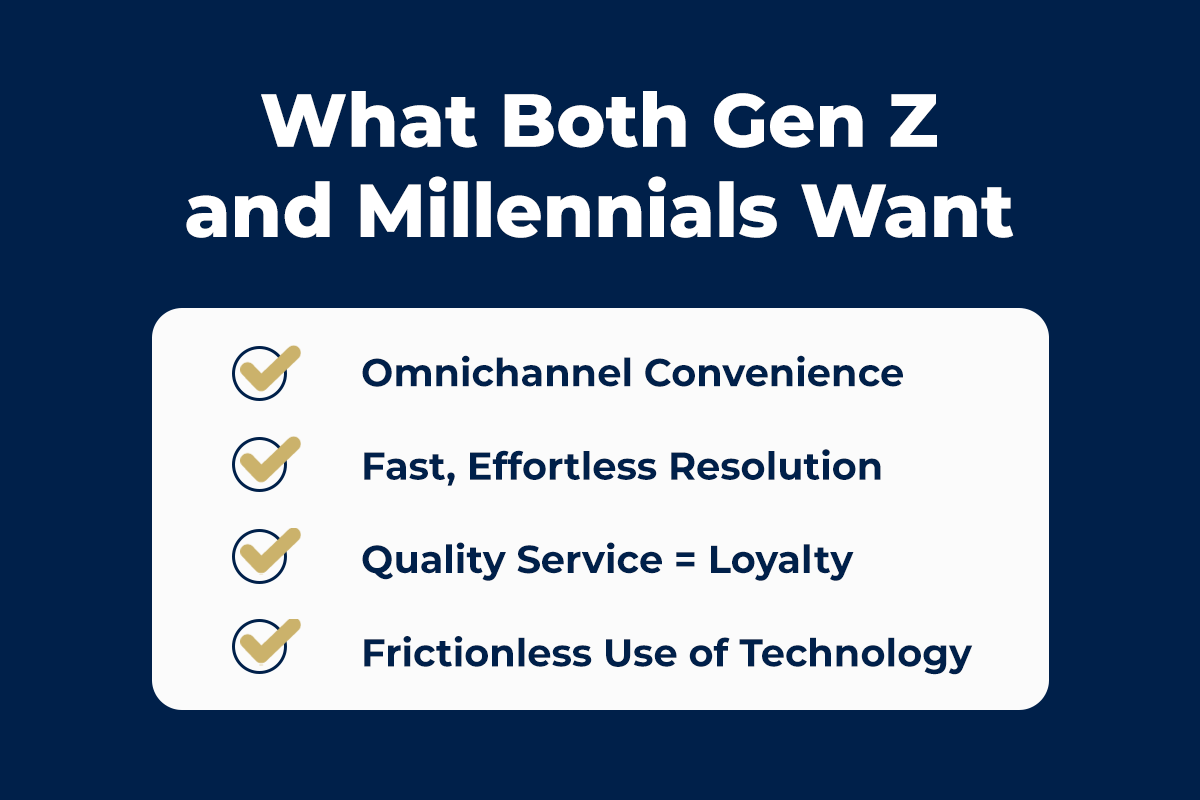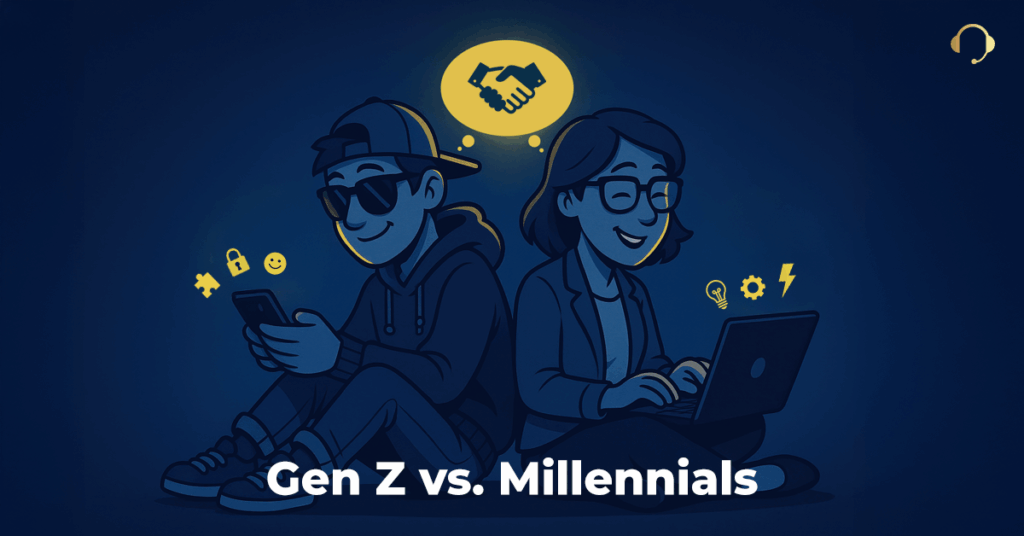Customer experience leaders today face a unique challenge: serving Millennial and Gen Z customers who, while close in age, have distinct expectations for support. These two cohorts make up the largest consumer base in history, together they command over $3 trillion in purchasing power. Brands must adapt to their preferences or risk becoming a meme in the eyes of these digitally savvy customers. In this article, we break down how Millennials and Gen Z expect customer support to cater to them differently, and how you can bridge the gap.
Who Are Millennials and Gen Z?
Millennials (also known as Gen Y) were born roughly 1981–1996, making them late 20s to early 40s as of today. They grew up during the rise of the internet but still remember life before smartphones and social media.
Gen Z (“Zoomers”) were born around 1997–2012, putting them in their teens to mid-20s now. Unlike Millennials, Gen Z is the first generation to grow up fully digital. Smartphones and social networks have been ubiquitous in their lives from the start.
These generational experiences shape how they interact with brands. Millennials recall an analog world and the early days of online customer service, whereas Gen Z expects a digital-first, seamless experience by default. Understanding their mindsets is key to delivering support that resonates with each group.
Key Differences in Customer Support Expectations
While both Millennials and Gen Z demand great service, research shows notable differences in their support preferences and priorities. Here are the major ways these generations diverge:
Speed and Responsiveness

Millennials are notoriously impatient when seeking help. In fact according to Zendesk, 80% of Millennials expect an instant response from support. They grew up with fast internet and on-demand service, and they won’t wait on hold.
Gen Z, surprisingly, shows a bit more patience, about 64% of Gen Z customers want an immediate reply. This younger cohort can tolerate slightly longer wait times than Millennials, possibly because they juggle multiple digital channels and know some issues take time.
The bottom line is that an ultra-fast response matters to both, but it’s absolutely critical for Millennials.
Service Quality and Loyalty
Both generations value quality support, but Millennials have higher expectations and lower tolerance for bad service. Over 62% of Millennials say they’d switch to a competitor after just one bad customer service experience, compared to 45% of Gen Z.
Millennials often feel that many brands don’t take service seriously enough, more than half say customer service seems like an afterthought at companies they interact with. Gen Z also dislikes poor service, but they’re a bit more forgiving than their Gen Y counterparts.
Takeaway: Millennials will walk away quicker, so nailing that first interaction is crucial to retain their loyalty.

Personalization
Millennials respond strongly to personalized service. Millennials are willing to spend more with brands that tailor experiences to them. They remember less personalized eras of service and appreciate when a brand knows them and their needs.
Gen Z also expects personalization, but they consider it a standard feature, not a premium perk. In fact, many Gen Z customers believe personalization shouldn’t be confined to luxury brands, it should be for everyone.
In short, Millennials demand personalization (and reward it with higher spend), whereas Gen Z assumes it will be there by default.

Self-Service and Independence
If there’s one area Gen Z clearly leads, it’s self-service. Growing up with Google and YouTube tutorials, Gen Z prefers to solve issues on their own whenever possible. Most Gen Z “zoomers” take time to research and compare options before buying, and one of their biggest customer service frustrations is not finding information online to help themselves.
Millennials also value self-service, but Gen Z takes DIY support to the next level.
Offering a robust knowledge base and FAQ empowers Gen Z and spares Millennial customers from unnecessary fatigue.
Preferred Communication Channels
Both young generations are digital natives who gravitate to online channels over phone calls. Millennials pioneered the shift to email, live chat, and social media support; Gen Z doubles down on these preferences.
During the pandemic, both Millennials and Gen Z increased their use of web chat for support, far more than older generations. Chatbots and messaging apps are especially popular with Gen Z. A majority of both groups say bots are helpful for simple issues, but Gen Z is a bit more comfortable with AI.
Millennials, while tech-savvy, are slightly more inclined to insist on a human agent, especially if a bot falters. And what about the good old telephone? Here, myths can be misleading: when a problem is really urgent or complex (think banking or a flight issue), a large share of Gen Z will pick up the phone just like older folks. Over half of under-30 consumers (Millennials and Gen Z) say they’ll call if they have to, especially for high-stakes issues. Routine inquiries though should have quick digital options, because neither group likes sitting on hold.
Data Privacy and Trust
Data privacy is a dividing line. Millennials tend to be more trusting that companies will protect their data. Millennials believe businesses are doing enough to secure their personal information.
Gen Z, having grown up amid high-profile data breaches and privacy scandals, is more skeptical. Gen Z customers are also careful about what they share. They’re less likely to overshare on social media and don’t want brands hoarding their data needlessly. Many Gen Zers feel resigned that data collection is inevitable (half say there’s nothing they can do about companies collecting their info), but that doesn’t mean they like it.
The key insight: transparency and security in how you handle customer data are essential, especially to earn Gen Z’s confidence. Millennials appreciate it too, they’ve just grown somewhat jaded unless a breach happens.
Brand Values and Social Impact
Both generations care about who they buy from, not just what they buy. Millennials and Gen Z want brands to be authentic, ethical, and socially responsible. They pay attention to a company’s stance on social issues and how it treats people and the planet. Millennials, in particular, are vocal when a company lets them down; they won’t hesitate to vent about a bad support experience on social media for all to see.
Gen Z shares many of these values (they’ve inherited Millennials’ skepticism and desire for authenticity), and they expect brands to take stands on environmental and social issues more than previous generations.
In practice, this means your support team isn’t just fixing problems; often they are brand ambassadors who need to embody your company’s values. A rude or indifferent service experience can clash with the inclusive, customer-centric image young consumers expect from modern brands.
Shared Expectations: What Both Gen Z and Millennials Want
Despite their differences, Millennials and Gen Z have a lot in common when it comes to customer service preferences. Understanding the common ground can help you create support experiences that please both:
Omnichannel Convenience
Both generations expect you to meet them on their terms. They prefer digital channels (live chat, messaging apps, social DMs, email) and will readily use self-service tools. If answers aren’t easily found online or via a quick chat, any young customer will be frustrated. In fact, failing to provide online solutions is a top complaint across both groups. The lesson is clear: offer 24/7 support across multiple channels so customers can reach you in the ways they like best.
Fast, Effortless Resolution
Millennials and Gen Z have grown up in an era of Amazon-level speed and convenience. They share a low tolerance for slow or difficult service. Long hold times, repeating information, or being bounced around reps will alienate any young customer. According to Forbes, Gen Z has an average attention span of only 8 seconds in the digital world and while that stat is debatable, it underscores that swift, efficient support is expected. Both generations want their issue resolved yesterday, and a smooth, hassle-free process will win their loyalty.
Quality Service = Loyalty
For both Gen Z and Millennials, customer service isn’t a trivial afterthought, it heavily influences their perception of your brand. Both Millennials and Gen Z say a single bad interaction can ruin their day, and a string of bad experiences can definitely send them packing. Conversely, great support drives repeat business: about three-quarters of Millennials and Gen Z report that a positive customer service experience makes them more likely to buy again. In short, everyone wants to be treated well and see their problems solved. If you deliver that consistently, both groups are more than happy to reward you with loyalty and positive word-of-mouth.
Comfort with Technology
Millennials may have witnessed the start of clunky automated phone systems, and Gen Z grew up with Siri and Alexa, but today both are quite comfortable with AI-driven support for simple tasks. A majority in each generation agree that chatbots and automation are helpful for basic issues. They’ll use virtual assistants, knowledge bases, and community forums willingly, as long as these tools actually work.
The crucial caveat: when things get complex, both Millennials and Gen Z want a human ready to step in. Ensure your support has a seamless path from bot to human agent so customers of any age don’t get stuck in a loop. Technology is great for speed, but the human touch still matters for empathy and nuanced problems.

How to Adapt Your Support for Millennials and Gen Z
Serving these two generations isn’t about choosing one over the other, you need to satisfy both. The good news is that by modernizing and personalizing your customer support, you’ll likely improve experiences for all customers. Here are some best practices to help you meet Millennial and Gen Z expectations:
-
Be Omnichannel and Always-On: An omnichannel support strategy is a must. Offer help across live chat, email, social media, SMS, and yes, phone; each channel has its moment. Both generations are online at all hours, so consider 24/7 coverage or at least extended hours to account for night owls. If you’re global or serve different time zones, around-the-clock availability becomes even more critical. A customer should be able to start on one channel and seamlessly continue on another. Meeting customers wherever they are will improve satisfaction across the board.
-
Prioritize Speed: Speed is the name of the game. Strive for real-time or near-real-time responses on instant channels. Use tools like live chat and messaging apps to handle quick queries fast. Implementing a live chat widget, chatbots for FAQs, and ensuring you have enough agents on deck during peak times will help keep response times low. Faster first responses and quick resolution should be key metrics for your support team.
-
Empower Customers with Self-Service: Both generations love the do-it-yourself approach when possible. Create a rich knowledge base with FAQs, how-to guides, and video tutorials so that customers can easily find answers without contacting support. Keep your help center well-organized and searchable. Consider community forums or user groups where customers can help each other. Just be sure to provide a clear path to a human agent if the customer can’t solve it solo, no one likes a self-service dead end.
-
Personalize the Experience: Treat customers as individuals, not tickets. Leverage your CRM data to greet them by name, remember past purchases or issues, and tailor solutions to their situation. Personalization shows you value them, which resonates strongly with Millennials and meets Gen Z’s baseline expectation that brands should be as savvy as the apps they use. A personalized touch can turn a support interaction into a loyalty-building moment for both groups.
-
Build Trust Through Transparency: Given the privacy concerns, transparency is key to earning young customers’ trust. Be upfront about how you use their data and what you do to protect it. Train your support team to handle sensitive customer data carefully and empathetically, a security incident or mishandled personal info can devastate trust among these demographics. On the flip side, companies that are open and ethical can turn security and privacy into a selling point that differentiates them.
-
Align with Customer Values: Younger consumers want to support companies that align with their values. Make sure your support policies and actions reflect things like fairness, social responsibility, and sustainability.
-
Gather Feedback and Keep Improving: Millennials, with their high standards, often have opinions to share about how you can do better. Solicit feedback after support interactions, especially from Millennial customers. Gen Z might not fill out long surveys, but they’ll give quick feedback via thumbs-up/down or a one-question poll. Use this input to continually refine your support. Showing that you listen and adapt will impress both groups. Additionally, keep an eye on social media sentiment, Millennials might be tweeting about their support experience, and Gen Z might be making a TikTok about it.
Bridging the Generational Gap with Ethos Support
Designing a customer support operation that delights both Millennials and Gen Z may sound demanding but you don’t have to do it alone. Ethos Support specializes in helping companies deliver exceptional support across all generations. As support specialists, we understand what it takes to satisfy the habits of each cohort. Ethos Support builds flexible, on-brand teams that provide 24/7/365 omnichannel service, so you can be there for customers whenever and wherever they reach out.
Whether you need a single agent or a fully staffed contact center, we scale to your needs, no minimum team size required. Our agents seamlessly integrate into your business and embody your brand values, functioning as a natural extension of your team.



